|
|
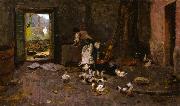 |
Mose Bianchi
|
|
(Monza, 1840-1904) was an Italian painter.
The family moved from Monza to Milan and Bianchi enrolled at the Brera Academy. Having interrupted his studies to serve in the second war of independence, he returned to attend the school of painting directed by Giuseppe Bertini. The award of a grant in 1867 enabled him to visit Venice and then Paris in 1869. He took part with some success at the Brera exhibitions and the Vienna Exhibition of 1873. It was in this period that he began to paint genre scenes in 18th-century settings and numerous portraits, soon becoming one of the artists most in demand with the Milanese middle classes. He returned to Venice in 1879 and visited Chioggia for the first time. Both places were to be featured also in later years in a series of intense views exhibited at exhibitions in Milan and Venice alongside genre scenes, views of Milan and landscapes of the countryside around Gignese.
|
|
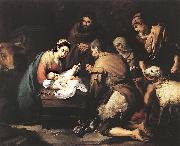 |
MURILLO, Bartolome Esteban
|
|
Spanish Baroque Era Painter, ca.1617-1682
Spanish religious and portrait painter. He was born in Seville, where most of his life was spent. There, c.1645, he painted a series of 11 pictures of the history of the Franciscan order for a monastery. These brought him immediate fame, and for the remainder of his life he was the favorite painter of the wealthy and pious Andalusian capital. His early works show the influence of Zurbarn in the dramatic use of light and shadow. Murillo adapted several compositions from northern and Italian prints. Notable works of his early years include St. Leander, St. Isidore, Vision of St. Anthony (all: cathedral, Seville), Birth of the Virgin (Louvre), and his series for the Church of Santa Maria la Blanca. In 1660 he was instrumental in founding the Seville Academy, of which he shared the presidency with the younger Francisco de Herrera. From 1670 to 1682, Murillo painted many of his major religious works, including those for the Charity Hospital and for the Capuchin convent (Seville Mus.). These religious works, particularly the Madonnas, are noted for their sweetness of mood. In 1682, while working on the Marriage of St. Catherine for the Capuchin church of Cediz, Murillo fell from a scaffold and died as a result of his injuries. Murillo's greatest works include his fine portraits, Don Andres de Andrade y la Col (Metropolitan Mus.) and Knight of the Collar (Prado) and his naturalistic genre paintings, such as Girl and Her Duenna (National Gall., Washington, D.C.) and Peasant Boy (National Gall., London). |
|
 |
Myles Birket Foster,RWS
|
|
1825-1899
English painter, illustrator and collector. After a short and unsatisfactory period working in the family brewing business, he was able to convince his Quaker parents to allow him to pursue a career in art. He was apprenticed to a wood-engraver, Ebenezer Landells (1808-60), who recognized Foster's talent for drawing and set him to work designing blocks for engraving. Foster also provided designs for Punch and the Illustrated London News. In 1846 he set up on his own as an illustrator. The rustic vignettes of the seasons that he contributed to the Illustrated London News and its counterpart, the Illustrated London Almanack, established him as a charming interpreter of the English countryside and rural life and led to his employment illustrating similar themes in other publications. During the 1850s his designs were much in demand; he was called upon to illustrate volumes of the poetry of Longfellow, Sir Walter Scott and John Milton. |
|
|
|
|
|
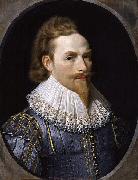 |
Nathaniel Bacon
|
|
(1585-1627) was a wealthy landowner from Culford, Suffolk, England.
self-portraitBacon was an exceptionally skillful amateur painter and gardener. Only a small group of 9 of his paintings survive. He was particularly known for his kitchen and market scenes, dominated by still-life depictions of large vegetables and fruit, often accompanied by a buxom maid, the most well known being "The Cookmaid with Still Life of Vegetables and Fruit" (Tate Gallery London). This predilection for cook or market scenes is much more common among Dutch and Flemish painters, see for example Joachim Beuckelaer (1533-1574), or from a later generation, Pieter Cornelisz van Rijck (1567-ca.1637), and Cornelis Jacobsz Delff.
Bacon is credited with the first known British landscape and also painted a self-portrait and a number of other portraits. He was created a Knight of the Bath in 1625, in honour of the Coronation of Charles I. He died at Culford Hall at the age of 42. He was buried there on 1 July 1627. His little daughter, Jane, aged three years, died that same October and is buried alongside her father. The entries of their burials follow each other in the Culford Parish Burial Register.
He was the son of Sir Nicholas Bacon, 1st Baronet. |
|
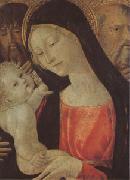 |
Neroccio di Bartolomeo
|
|
1447 - 1500
was an Italian painter and sculptor of the early-Renaissance or Quattrocento period in Siena. He was a student of Vecchietta, and then he shared a workshop with Francesco di Giorgio from 1468. He painted Scenes from the life of St Benedict, now in the Uffizi, probably in collaboration with di Giorgio, and a Madonna and Child between Saint Jerome and Saint Bernard, which is in the Pinacoteca of Siena. In 1472 he painted an Assumption for the abbey of Monte Oliveto Maggiore, and in 1475 he created a statue of Saint Catherine of Siena for the Sienese church dedicated to her. He separated from di Giorgio in 1475. In 1483, he designed the Hellespontine Sybil for the mosaic pavement of the Cathedral of Siena, |
|
 |
Niccolo Bambini
|
|
(1651-1736) was an Italian painter of the late-Renaissance and early-Baroque periods.
He was born in Venice, and first studied under Giulio Mazzoni at Venice; but afterwards went to Rome, where he became a pupil of Carlo Maratti. He painted for the church of San Stefano soon after his return from Rome. He died in Venice. He had two sons who were painters, Giovanni and Stefano. |
|
|
|
 |
Nicolaas Baur
|
|
who was born at Harlingen in 1767, was the son of Hendricus Antonius Baur, a portrait painter (born 1736, died 1817). He painted landscapes and views of cities, and many houses in Holland are embellished by his works. He also painted moonlight and winter scenes; and was particularly successful in marine subjects. He is considered one of the best of the later Dutch marine painters. He died at Harlingen in 1820.
|
|
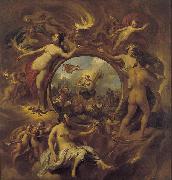 |
Nicolaes Pietersz. Berchem
|
|
(1 October 1620 - 18 February 1683) was a highly esteemed and prolific Dutch Golden Age painter of pastoral landscapes, populated with mythological or biblical figures, but also of a number of allegories and genre pieces.
Born in Haarlem, he received instruction from his father Pieter Claesz, and from the painters Jan van Goyen, Pieter de Grebber, Jan Baptist Weenix, Jan Wils and Claes Cornelisz. Moeyaert.According to Houbraken, Carel de Moor told him that Berchem got his name from two words "Berg hem" for "Save him!", an expression used by his fellows in Van Goyen's workshop whenever his father chased him there with the intent to beat him. No trip or Grand Tour by Berchem was documented by Houbraken though he mentioned another story about the "Berg hem!" nickname which came from Berchem's conscription as a sailor; the man in charge of impressment knew him and sent him ashore with the words "Save him!".Today his name is assumed to come from his father's hometown of Berchem, Antwerp. According to the RKD he traveled to Italy with Jan Baptist Weenix, whom he called his cousin, in 1642-5. Works by him are signed both as "CBerghem" and "Berchem". |
|
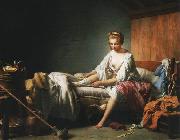 |
Nicolas Bernard Lepicie
|
|
was a French painter (16 June 1735 - 15 September 1784), the son of two reputed engravers at the time, Francois-Bernard and Renee-Elisabeth, was introduced to the artistic and cultural environment by his parents.
Nicolas-Bernard studied with reputed artists of the century including Carle Vanloo. In 1769 he was accepted to the Royal Academy of Painting and Sculpture in Paris. Three years later, in 1770, he became an assistant professor and, in 1777, a professor. Important names such as Carle Vernet, Jean-Frederic Schall, Jean-Antoine-Theodore Giroust, Jean-Joseph Taillasson, Henri-Pierre Danloux, Jean-Baptiste Regnault and Nicolas-Antoine. |
|
|
|
|
|
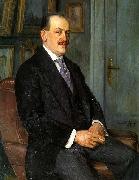 |
Nikolay Bogdanov-Belsky
|
|
(Russian 1868-1945) was a Russian painter.
Bogdanov-Belsky was born in the village of Shitiki in Smolensk Governorate in 1868. He studied art at the Semyon Rachinsky fine art school, icon-painting at the Troitse-Sergiyeva Lavra in 1883, modern painting at the Moscow School of Painting, Sculpture and Architecture in 1884 to 1889, and at the Imperial Academy of Arts in St. Petersburg from 1894 to 1895. He worked and studied in private studios in Paris in the late 1890s.
Bogdanov-Belsky was active in St. Petersburg. After 1921, he worked exclusively in Riga, Latvia. He became a member of several prominent societies in including the Peredvizhniki from 1895, and the Arkhip Kuindzhi Society from 1909 (of which he was a founding member and chairman from 1913 to 1918).
Bogdanov-Belsky painted mostly genre paintings, especially of the education of peasant children, portraits, and impressionistic landscapes studies. He became pedagogue and academician in 1903. He was an active Member of the Academy of Arts in 1914. Bogdanov-Belsky died in 1945 in Berlin.
He was a member of the Russian Fraternitas Arctica in Riga.
|
|
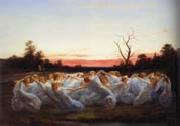 |
Nils Blommer
|
|
1816 - 1853,was a Swedish painter. Starting his career as an apprentice in Lund he experimented with painting portraits from the age of 20. He achieved some successes and in 1839 he had saved up enough money to move to Stockholm. There he took the name Blomm??r and enrolled in the Fria konsternas akademi. After winning the academy's prize several times he got a stipend in 1847 to travel abroad. He spent time in Paris but later moved to Italy, where he married his wife Edla Gustafva Jansson, also a painter, in November 1852. A few months later he caught a fatal chest disease |
|
|
|
|
|
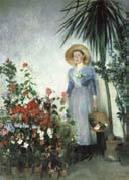 |
Olga Boznanska
|
|
Krakow 1865-1940 Paris,Polish painter. She took drawing lessons at home from the age of nine and began regular studies in 1883 under the portrait painter Kazimierz Pochwalski (1855-1940). She continued her training in 1884-5 at the Adam Baraniecki School of Art, the only school in Krakew accessible to women at that time. She went to Munich for further study, working in the studio of Carl Kricheldorf (b 1863) in 1886-7, and in that of Wilhelm Derr (1857-1900) in 1888. In 1889 she participated in the Internationale Kunstausstellung in Munich and opened her own studio, which over the next decade became a meeting-place for students. In 1895 she ran a private school of painting founded by Professor Theodor Humml (1864-1939). |
|
|
|
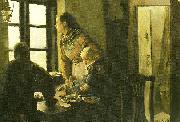 |
oscar bjorck
|
|
född 15 januari 1860 i Stockholm, död av en hjärtattack i sitt hem klockan 03.00 den 5 december 1929, var en svensk konstnär och professor vid Konsthögskolan 1898-1925, och från 1918 även vice preses.
Åren 1877-1882 var han elev till Edvard Pers??us vid konstakademins principskola och målade bland annat prisämnena Loke fängslas af asarne (1880), Gustaf Vasa inför kung Hans (1881) och Den förlorade sonens återkomst (1882, belönad med kungliga medaljen). 1883 fick Björck akademiskt resestipendium och vistades vintern 1883?C84 i Paris. Vintern 1884?C85 reste Björck till M??nchen, målade några porträtt, bland annat ett i helfigur av sin hustru. Våren 1885 flyttade han till Venezia och på hösten till Rom. Där målade han den stora modelltavlan Susanna (Göteborgs museum) och Romerska smeder (galleriet i Washington, en skiss till samma tavla finns i Göteborgs museum). 1887 målades i Venezia Veneziansk saluhall (nationalmuseum), Lördagsmässa i Markuskyrkan och andra tavlor.
Efter en sommarvistelse på Skagen, där han förut tillbringat två somrar, 1882 och 1884, bosatte sig Björck 1888 i Stockholm. Han har sedan huvudsakligast målat porträtt. Bland dessa kan nämnas flera av konung Oscar (bland dem ett på Skokloster, ett i helfigur på Drottningholm, ett med krona och mantel, på Stockholms slott, ett som övergick i tyske kejsarens ägo), prins Eugen vid staffliet (nationalmuseum, 1895), kronprins Gustaf (Stockholms slott, 1900), konstnärens hustru (helfigur, 1891, Göteborgs museum) och friherre Nordenfalk (konstakademien, 1892). Dessutom skapade han några landskap, ett par genrebilder och olika dekorativa målningar.
Från 1889 var han ledamot vid konstakademin och lärare vid Konsthögskolan. 1898 blev han professor.
Björck var kommissarie för konstavdelningen vid Stockholmsutställningen 1897 och vid Baltiska utställningen 1914 samt för den svenska utställningen i London 1924. |
|
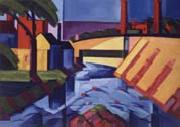 |
Oscar Bluemner
|
|
German-born American Painter, 1867-1938,was a German-born American Modernist painter. He was born in Hanover, Germany. He moved to Chicago in 1893 where he freelanced as a draftsman. He relocated to New York in 1901. In 1910 he met Alfred Stieglitz, who introduced him to the artistic innovations of the European and American avant-garde. Then in 1915 Stieglitz gave him a solo exhibition at his gallery, 291. |
|
|
|
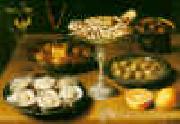 |
Osias Beert
|
|
1580-1624
Flemish
Osias Beert Galleries
Flemish painter. In 1596 he went to study with Andries van Baseroo and in 1602 became a master in the Antwerp Guild of St Luke; these two dates suggest his probable date of birth. Beert married Marguerite Ykens on 8 January 1606. Contemporary documents describe him as a cork merchant. The esteem enjoyed by Beert is indicated by the large number of pupils he had, including, in 1610, Frans van der Borch; in 1615, Frans Ykens; in 1616, Paulus Pontius; and, in 1618, Jan Willemssen. Beerts son, Osias Beert the younger (1622-78), was also a painter and became a master in 1645.
|
|
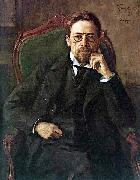 |
Osip Braz
|
|
painted Portrait of Anton Pavlovich Chekhov in 1898 |
|
|
|
|
|
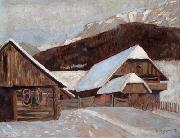 |
Otto Barth
|
|
(18 June 1891 - 3 May 1963) was a highly decorated Generalmajor in the Wehrmacht during World War II who commanded the 30. Infanterie-Division. He was also a recipient of the Knight's Cross of the Iron Cross. The Knight's Cross of the Iron Cross was awarded to recognise extreme battlefield bravery or successful military leadership. Otto Barth was captured by Soviet troops following the fall of the Courland Pocket in 1945. He was held until 1955.
|
|
|
|
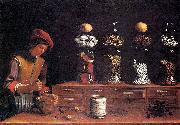 |
Paolo Antonio Barbieri
|
|
(1603-1649) was an Italian painter who was the brother of Guercino. He was born at Cento, a village near Bologna. The subjects of his pictures are flowers, fruit, and game, but he particularly excelled in painting fish |
|
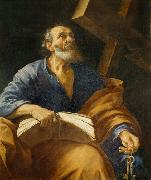 |
Paolo Emilio Besenzi
|
|
(1608-1656) was an Italian painter of the 17th century, born and active in Reggio. He trained with Francesco Albani. Friend and companion of Lionello Spada, he painted for the church of San Pietro. He was also known as sculptor and architect.
|
|
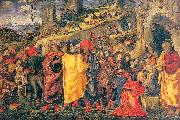 |
Parentino, Bernardo
|
|
Italian Painter, 1437-1531
was an Italian painter of the Renaissance period, active mainly in Padua. Born in Parenzo, then a Venetian town in Istria and died in Vicenza. He was influenced, if not a pupil, of the painter Andrea Mantegna. He became an Augustinian monk under name of Lorenzo. He painted Scenes of the life of San Benedetto for the cloister of Santa Giustina at Padua, and a Nativity once at the Accademia in Venice. He painted a nightmarish Temptation of St. Anthony Abbot found at the Doria Pamphilj Gallery. An Adoration of the Magi |
|
|
|
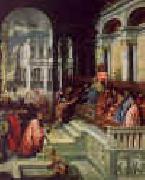 |
Paris Bordone
|
|
Italian
1500-1571
Italian painter and draughtsman. He is best known for his strikingly beautiful depictions of women, both in portraits and in cabinet paintings. He also excelled in rendering monumental architectural settings for narrative, both religious and secular, possibly initiating a genre that would find great currency during the mid-16th century, especially in Venice, France and the Netherlands. His favoured media were oil and fresco, the latter being used on both interiors and faades. Although he was not generally sought after by Venetian patrons during his career, as his art was eclipsed by that of Titian, Paolo Veronese and Jacopo Tintoretto, Bordone was regarded in the mid-16th century as an accomplished artist (Pino; Sansovino). He worked for the moneyed lite of northern Italy and Bavaria, for the royalty of France and Poland, and had works commissioned to be sent to Spain and to Flanders. Despite knowledge of the important patrons for whom he worked, the chronology of Bordones oeuvre is by no means clear. Dating on stylistic grounds is confounded by the diverse sources on which he drew, ranging from the Emilian, Lombard and Venetian to the French and northern European, depending on the patron. Due to the ease with which prints circulated during Bordones career, it is difficult to ascertain whether influences were derived at first hand or from printed images. Such difficulties in assigning dates are further exacerbated by his use of the same figure study for numerous paintings evidently executed decades apart. Reliance on the testimony of Vasari, who interviewed Bordone in 1566, in conjunction with the extant documents, the few signed and dated paintings and, to a lesser extent, period fashion provides only a rough outline of his activity. Due to the lack of agreement among scholars regarding chronology, the following account is based mainly on the documentary evidence. |
|
 |
Pascal Dagnan-Bouveret
|
|
(January 7, 1852 - July 3, 1929), was one of the leading French artists of the academic school. He was born in Paris, the son of a tailor, and was raised by his grandfather after his father emigrated to Brazil. Later he added his grandfatheres name, Bouveret, to his own.
From 1869, he studied at the Ecole des Beaux-Arts under Alexandre Cabanel and Jean-Leon Gerôme. In 1873, he opened his own studio with a fellow student Gustave-Claude-Etienne Courtois. From 1875, he exhibited at the Salon, where in 1880 he won the first-class medal for the painting An Accident, and a medal of honour in 1885 for Horses at the Watering Trough.
From the 1880s, Dagnan-Bouveret along with Gustave Courtois, maintained a studio in Neuilly-sur-Seine, a fashionable suburb of Paris. By that time he was recognized as a leading modern artist known for his peasant scenes, but also for his mystical-religious compositions. His large-scale painting The Last Supper was exhibited at the Salon de Champ-de-Mars in 1896.[1] He also painted portraits for wealthy clients including the British collector George McCulloch. He was one of the first to use the then new medium of photography to bring greater realism to his paintings.
In 1891, he was made an Officer of the Legion of Honour; in 1900 he became a member of the Institut de France.
|
|
|
|
 |
Patrick Henry Bruce
|
|
American Cubist Painter, 1881-1936
was an American cubist painter. A descendant of Patrick Henry, Bruce was born in Campbell County, Virginia, the second of four children. His family had once owned a huge plantation, Berry Hill, worked by over 3,000 slaves. Berry Hill is now a resort & conference center outside South Boston, Virginia and is now a National Historic Landmark. Berry Hill Estate originally was part of a 105,000-acre (420 km2) tract granted by the English Crown in 1728 to William Byrd II. The Civil War left the Bruce's wealth greatly diminished. Bruce began taking evening classes at the Art Club of Richmond in 1898, while working in a real estate office during the daytime. His earliest known extant painting dates from 1900. In 1902 he moved to New York, where he studied with William Merritt Chase, Robert Henri, and Kenneth Hayes Miller. By February 1904 he was in Paris, where he would live until 1933. Although his evolution toward a modernist style was gradual, his works of 1908 reveal the influence of Renoir and C??zanne, and in that year he was among the first to enroll in Matisse's school. Bruce exhibited regularly in the Salon d'Automne, and met many of the leading artists of the early twentieth century avant garde. |
|
 |
Paul Barthel
|
|
painted Interieur mit geoffneter Vitrine in 1862 - 1933 |
|
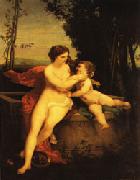 |
Paul Baudry
|
|
French Academic Painter, 1828-1886. Specializes in Portraits
Specializes in Portraits.was a French painter. He studied under Michel Martin Drolling and carried off the Prix de Rome in 1850 by his picture of Zenobia found on the banks of the Araxes. His talent from the first revealed itself as strictly academical, full of elegance and grace, but somewhat lacking originality. In the course of his residence in Italy Baudry derived strong inspiration from Italian art with the mannerism of Correggio, as was very evident in the two works he exhibited in the Salon of 1857, which were purchased for the Luxembourg: The Martyrdom of a Vestal Virgin and The Child. His Leda, St John the Baptist, and a Portrait of Beul, exhibited at the same time, took a first prize that year. Throughout this early period Baudry commonly selected mythological or fanciful subjects, one of the most noteworthy being The Pearl and the Wave (1862). Once only did he attempt an historical picture, Charlotte Corday after the murder of Marat (1861); and returned by preference to the former class of subjects or to painting portraits of illustrious men of his day: Guizot, Charles Garnier, Edmond About. The works that crowned Baudrys reputation were his mural decorations, which show much imagination and a high artistic gift for color, as may be seen. in the frescoes in the Paris Court of Cassation. at the château of Chantilly, and some private residences the Hôtel Fould and Hôtel Paivabut, above all, in the decorations of the foyer of the Opera Garnier. These, more than thirty paintings in all, and among them compositions figurative of dancing and music, occupied the painter for ten years. Baudry was a member of the Institut de France, succeeding Jean-Victor Schnetz. Two of his colleagues, |
|
|
|
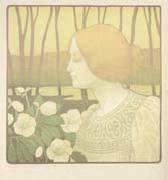 |
Paul Berthon
|
|
A truly gifted illustrator and poster artist ,
French , 1872-1909
French designer and lithographer. He began his training in Villefranche, where he studied painting, and in 1893 he moved to Paris, entering the Ecole Normale d'Enseignement du Dessin. There he became a pupil and disciple of Eug?ne-Samuel Grasset, the Professor of Decorative Arts, and was also influenced by Luc Olivier Merson. Berthon's main output consisted of posters and decorative panels. However, he also produced bookbindings and furniture designs, both of which he exhibited at the Salon in 1895; designs for ceramics for Villeroy & Boch in the late 1890s; and a few designs for the covers of such magazines as L'Image (July 1897) and Poster (May 1899). His work is in an Art Nouveau style, and he adopted that movement's plant and figural motifs, especially the motif of the femme fatale, and also its long sinuous lines. |
|
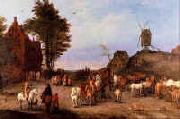 |
Paul Bril
|
|
Flemish Baroque Era Painter, ca.1554-1626
Paul (1554-1626) and Mattheus (1550-1583) Brill (or Bril) were brothers, both born in Antwerp, who were landscape painters who worked in Rome after earning papal favor. They are also described as painters of capricci (whims or fancies) or vedute ideate or veduta di fantasia, with typical rustic hills with a few ruins. Mattheus began work on several frescoes in Rome from 1570 onwards, and his work includes the Vatican Seasons. Mattheus died young, and his brother continued his work around 1574. Paul painted frescoes such as the landscapes in the Casino Rospigliosi (Rome), and The Roman Forum, which showed this site for what it had become: a slum for squatters and pasture for livestock (so much so that the place was nicknamed Campo Vaccino, or The Cowfield). His masterpiece may be a fresco in the Clementine Hall of the Vatican.
Paul also did engravings and small cabinet paintings on copper, some of which are signed with a pair of spectacles (a pun on the French word brilles, spectacles). Some of these were collaborations with Johann Rottenhammer, who according to a dealer letter of 1617 painted the figures in Venice and then sent the plates to Rome for Bril to complete the landscape. He collaborated with his friend Adam Elsheimer, who he both influenced and was influenced by, on one painting (now Chatsworth House) |
|
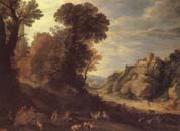 |
Paul Brill
|
|
Flemish painter , 1554-Rome 1626
were brothers, both born in Antwerp, who were landscape painters who worked in Rome after earning papal favor. They are also described as painters of capricci (whims or fancies) or vedute ideate or veduta di fantasia, with typical rustic hills with a few ruins. Mattheus began work on several frescoes in Rome from 1570 onwards, and his work includes the Vatican's Seasons. Mattheus died young, and his brother continued his work around 1574. Paul, a student of Damiaen Oertelmans, painted frescoes such as the landscapes in the Casino Rospigliosi (Rome), and The Roman Forum, which showed this site for what it had become: a slum for squatters and pasture for livestock (so much so that the place was nicknamed Campo Vaccino, or "The Cowfield"). His masterpiece may be a fresco in the Clementine Hall of the Vatican. Paul also did engravings and small cabinet paintings on copper, some of which are signed with a pair of spectacles (a pun on the French word brilles, "spectacles"). Some of these were collaborations with Johann Rottenhammer, who according to a dealer's letter of 1617 painted the figures in Venice and then sent the plates to Rome for Bril to complete the landscape. He collaborated with his friend Adam Elsheimer, who he both influenced and was influenced by, on one painting. |
|
|
|
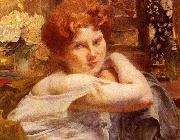 |
Paul-Albert Besnard
|
|
(2 June 1849 --4 December 1934) was a French painter and printmaker.
He was born in Paris and studied at the École des Beaux-Arts, studied with Jean Bremond and was influenced by Alexandre Cabanel. He won the Prix de Rome in 1874 with the painting Death of Timophanes
Until about 1880 he followed the academic tradition, but then broke away completely, and devoted himself to the study of colour and light as conceived by the Impressionists. The realism of this group never appealed to his bold imagination, but he applied their technical method to ideological and decorative works on a large scale, such as his frescoes at the Sorbonne, the Ecole de Pharmacie, the ceiling of the Comedie-Française (main theatre in Paris), the Salle des Sciences at the Hôtel de Ville, the mairie of the Ier arrondissement, and the chapel of Berck hospital, for which he painted twelve Stations of the Cross in an entirely modern spirit.
A great virtuoso, he achieved brilliant successes alike in watercolour, pastel, oil and etching, both in portraiture, in landscape and in decoration. His close analysis of light can be studied in his picture La femme qui se chauffe at the Luxembourg in Paris, one of a large group of nude studies of which a later example is Une Nymphe au bord de la mer; and in the work produced during and after a visit to India in 1911. A large panel, Peace by Arbitration, was completed seven days before the outbreak of war in 1914. |
|
|
|
 |
Paula Modersohn-Becker
|
|
German
1876-1907
Paula Becker was born and grew up in Dresden-Friedrichstadt. She was the third child of seven children in her family. Her father who was the son of a Russian university professor, was employed with the German railway. He and Modersohn-Becker's mother, who was from an aristocratic family, provided the children a cultured and intellectual environment in the house hold.
Modersohn-Becker's parental home 1888-1899In 1888 her parents moved from Dresden to Bremen. While visiting an aunt in London, England, she received her first instruction in drawing. Apart from her teacher's training in Bremen in 1893-1895, Paula took private instruction in painting. In 1896 she participated in a course for painting and drawing sponsored by the "Verein der Berliner K??nstlerinnen" (Union of Berlin Female Artists) which offered art studies to women.
Paula Modersohn-Becker. Clara Rilke WesthoffAt the age of 22, she encountered the artistic community of Worpswede. In this "village", artists such as Fritz Mackensen (1866-1953) and Heinrich Vogeler (1872-1942) had retreated to protest against the domination of the art academy and life in the big city. At Worpswede, Paula Modersohn-Becker took painting lessons from Mackensen. The main subjects were the life of the farmers and the northern German landscape. At this time she began close friendships with the sculptor Clara Westhoff (1875-1954) and the poet Rainer Maria Rilke (1875-1926). She also fell in love during this period, and in 1901 she married a fellow Worpswede painter, Otto Modersohn. In marrying Otto, she also became a stepmother to Otto's daughter, Elsbeth Modersohn, the child from his first marriage to Helene Modersohn, then deceased.
Paula Modersohn-Becker. Rainer Maria Rilke, 1906Between 1900 and 1907, Paula made several extended trips to Paris for artistic purposes, sometimes living separately from her husband, Otto. During one of her residencies in Paris, she took courses at the Ecole des Beaux-Arts. She visited contemporary exhibitions often, and was particularly intrigued with the work of Paul C??zanne. Other post impressionists were especially influential, including Vincent Van Gogh and Paul Gauguin. Fauve influences may also appear in such works as Poorhouse Woman with a Glass Bottle. The influence by the work of French painter, Jean-Francois Millet, who was widely admired among the artists in the Worpswede group, may be seen in such pieces as her 1900 Peat Cutters.
Reclining Mother and ChildIn her last trip to Paris in 1906, she produced a body of paintings from which she felt very great excitement and satisfaction. During this period of painting, she produced her initial nude self-portraits (something surely unprecedented by a female painter) and portraits of friends such as Rainer Maria Rilke and Werner Sombart. Some critics consider this period of her art production to be the strongest and most compelling.
Paula with Mathilde, November 1907 (days before Paula's death)In 1907, Paula Modersohn-Becker returned to her husband in Worpswede. Their relationship, which had been particularly strained in 1906, had taken a turn towards improvement. Paula's long-lived wish to conceive and bear a child was fulfilled. Her daughter Mathilde (Tillie) Modersohn was born on November 2, 1907. Paula and Otto were joyous. Sadly, the joy became soon overshadowed by tragedy, as Paula Modersohn-Becker died suddenly in Worpswede on November 20th from an embolism.
In 1908, Rainer Maria Rilke wrote the renowned poem, "Requiem for a Friend", in Paula's memory. The poem was born of the imprint that Paula's life, death and friendship left upon Rilke. |
|
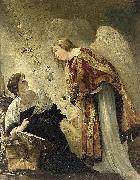 |
Paulus Bor
|
|
(Amersfoort, c. 1601 - Amersfoort, 10 August 1669) was a Dutch painter.
Bor was descended from a notable Catholic family. He made a study trip to Rome, where he was one of the founders of the Bentvueghels, taking the nickname Orlando. He returned in 1626 to Amersfoort and joined Jacob van Campen in the decoration of the palace Honselaarsdijk belonging to Frederik Hendrik. In 1656, he became regent of the godshuis "De Armen de Poth" in Amersfoort.
Bor's style of painting was rather at odds with that of contemporary painters from Utrecht. He initially painted rather Caravaggisti-like history paintings, but his works fast became marked by a classicism related to that of his townsman van Campen. Through unusual compositions and primitive technique, his paintings depict strange and mysterious subjects.
|
|
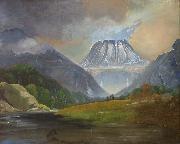 |
Peder Balke
|
|
Peter Andersen was born on the island of Helgøya, in Hedmark county, Norway. He grew up Ringsaker, but stayed in the 1820s on the Balke farm in Toten in Oppland county. Farmers in Toten paid his education, and as thanks he decorated several of the farms in Toten on his return. They actively encouraged his painting activities and later supported him in higher education.
In the autumn of 1827, Balke served as an apprentice to Heinrich August Grosch. he was also a student at the Tegneskole under Grosch and Jacob Munch. Balke signed a two year contract as an apprentice at the Danish decoration and artist Jens Funch. From autumn 1829 to spring 1833, he was a pupil of Carl Johan Fahlcrantz at the art academy in Stockholm. Balke was also a pupil of Johan Christian Dahl from 1843 to 1844.
During the summer of 1830 he walked through Telemark, Rjukan, Vestfjorddalen over Røldal and Kinsarvik to Bergen, and then back over Vossevangen to Gudvangen, further over Fillefjell to Valdres and thence across the mountains to Hallingdal. All the way he painted and drew small sketches that were later developed into paintings. He also traveled to Germany, and Russia. He visited Paris and London.
In Stockholm, he completed several of the paintings he had outlined of his Finnmark tour. Some of these were sold to the royal family. In 1846 he sold thirty of his paintings to Louis-Philippe of France for Versailles. Besides the 17 paintings in the National Gallery in Oslo, Peder Balke also is represented at several major art collections in Norway and Sweden.
|
|
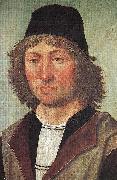 |
Pedro Berruguete
|
|
(c. 1450 - 1504) was a Spanish painter; his art is regarded as a transitional style between gothic and Renaissance. Born in Paredes de Nava, Spain, he went to Italy in 1480 and worked in Federigo da Montefeltro's court in Urbino, where he could see some works by Melozzo da Forle. He came back to Spain in 1482 and painted in several cities, such as Sevilla, Toledo and Ávila. He was the father of an important sculptor, Alonso Berruguete, considered the most important sculptor in Renaissance Spain.
|
|
|

